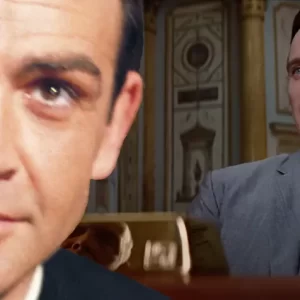Filming Goldeneye’s Bungee Jump: A Record-Breaking Stunt in the Making
Goldeneye opens with a perilous bungee jump of the Verzasca hydro-electric dam in Locarno, Switzerland. The jump off the 220 meter dam, performed by stuntman Wayne Michaels, holds the World Guinness Record for “the highest bungee jump from a structure in a film.” This is how the Bond crew filmed it.
Verzasca Dam doubles as the fictional Arkangel Dam in Soviet Russia. It’s a signature moment that exhibits the confidence with which EON Productions and director Martin Campbell approached Pierce Brosnan’s first Bond film. Like Bond’s ski-BASE jump at the beginning of The Spy Who Loved Me, the bungee jump in Goldeneye makes the statement that Bond is here to stay after the lackluster box office performance of the previous film.
Often called the “best Bond stunt”, the bungee jump was an important feature of Goldeneye‘s marketing campaign, taking pride of place in the film’s teaser and theatrical trailers. But it’s over in the first 1 minute and a half of the film. Bond only uses the jump so he can enter a Soviet chemical weapons facility at the bottom of the dam.
The bungee jump was a nod to Campbell’s home country New Zealand, which first commercialized the popular adventure sport. James Bond–the man who has done almost everything–would have to add bungee jumping to his bucket list. And EON found the perfect way to use it in Goldeneye.
“You know we used to sit down and say, ‘What have the audience never seen before?'” Campbell told James Bond Radio. “Well, in the case of Goldeneye, it was, you know, who would jump off a dam [other than Bond]—an 800-foot jump on a dam. And that had never been seen before.”

Stuntman Wayne Michaels (left) and Stunt Coordinator Simon Crane (right) played pilots of the Tiger Helicopter in Goldeneye. Unfortunately both are shot dead by Xenia Onatopp who steals the chopper.
The Infamous Oxford Stunt Factory Consulted on the Bungee Jump
The bungee jump took two weeks to prepare, to mitigate as much danger as possible, and involved the university group that invented modern bungee jumping: the famous—if not infamous–Oxford Stunt Factory.
They consulted EON on the stunt, along with Stunt Coordinator Simon Crane and Michaels, who wanted to help plan the very stunt he was set to perform.
Previously known as Dangerous Sports Club, the University of Oxford group was formed in the late ’70s and is credited with pioneering hang gliding as well as inventing modern bungee jumping. The club was inspired by “vine jumping”, performed by indigenous men of the southern part of Pentecost Island, Vanuatu. David Kirke, who founded the Dangerous Sports Club, and Simon Keeling had no intention of tying two vines to their ankles like the men in Vanuatu. Instead, with the assistance of mountaineer, Geoff Tabin, they used bungee cord, hence the name of the sport.
The Dam Should Be Vertical

Verzasca Dam in Locarno, Switzerland had enough of a vertical drop for the bungee jump (right) (Image: Wikipedia)
Much effort had gone into selecting a dam that was vertical enough for the stuntman to make his jump. Verzasca dam has a near vertical drop but slopes out at the bottom. Its concave design helped create a vortex as the wind blew up the dam.
In the audio commentary to Goldeneye: The Ultimate Edition, producer Michael G. Wilson recalled that Michaels “wasn’t concerned so much about hitting it [the dam] on the way down, but the bungee rope bounces back. And he was afraid he was going to scrape himself against the wall.”
“I was required to do a perfect swallow dive off the top of this dam at over 700 feet,” Michaels recalled in the 1995 documentary, The Making of Goldeneye. “So I physically had to hold this position while hitting really an area in space that would enable me to track away from the wall all the time and so limit the chances of me actually hitting the wall.”
The team planned on testing the jump with a sophisticated dummy. But after they couldn’t get the dummy, they used a tree trunk instead.
Filming the Bungee Jump

Image: Danjaq
The bungee jump was filmed on 11th March 1995.
Six cameras filmed the stunt. A trauma clinic was on standby and an emergency helicopter circled close by in case anything went wrong.
“The vision that sticks in my mind,” Michaels remembered, “is standing up there and they’ve got all the cameras up to speed and the assistant is just about to give me action and I could see out of the corner of my eye this little Italian crane driver, who looks pale with fright at the thought of what I was doing. And just as I’m about to go, he does the sign of the crucifix. And you know you have to live with that sort of thing. You realize it’s quite a crazy life you lead.”
Everything you see on screen was done for real. No digital effects. No articulated dummy. According to the director, Michaels performed the bungee jump only once. The cameras all worked perfectly, especially the two to the side of the dam which captured Michaels’ perfect swallow dive and followed him as he dropped to the bottom of the dam and pulled out his gun. The very next shot is a closeup of Brosnan’s eyes shot at Pinewood Studios. It’s a seamless transition from stuntman to actor. The opening minute and a half is a great introduction to a new James Bond.
A bungee jump is a difficult stunt to make in the confines of a story, but it works well as Bond’s entrance to a secret facility at the bottom of a dam. The rest of Goldeneye doesn’t disappoint but the bungee jump is a standout moment and remains one of cinema’s greatest stunts nearly thirty years on.


